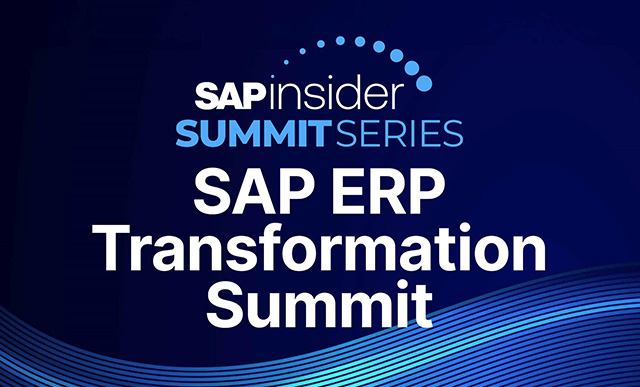HR
Venki Krishnamoorthy answers questions about appraiser leaves, implementing Performance Management, iViews, and integrating Enterprise Performance Management and SAP ERP HCM.
I often hear from readers of my articles asking me questions that are based on my implementation experience. Here I’ve gathered four of the most common questions I'm asked about Performance Management.
Tip #1
SAP ERP HCM Performance Management: Business Processes During the Appraisal Cycle
I’ve been hearing more and more questions about how to handle specific business requirements. Here are some of the scenarios I’ve come up against and how I’ve resolved the challenges they represent.
Scenario 1
The appraiser involved in defining the objectives/review with the appraisee leaves, and a new appraiser (supervisor) takes his/her place. What is the best practice to change appraisers (add or delete) during the life cycle of an appraisal document?
During the appraisal cycle, there is always the possibility that the appraiser (supervisor) who created the objectives might leave the organization or move on to a different position. When this happens, the appraiser’s name in the appraisal document needs to be replaced with the new appraiser’s name.
You do this by opening the appraisal document and clicking the Change Header Data button (Figure 1).

Figure 1
Change the appraiser name in the appraisal document
You have to do this for every appraisal document, which can be time consuming. SAP has not yet provided an option for mass-changing the appraiser’s name across all relevant appraisal documents.
What I suggest to my customers is that they develop a program in which the appraiser name can be changed in one go, in all the required appraisal documents. Once, the appraiser name is changed in the appraisal documents, all other settings remains the same and the document can be processed as before.
If the old appraiser has been the supervisor for six or more months, then they can be assigned to be a part-appraiser in the document. When you have a part-appraiser in the document, you need to determine the weight in the overall appraisal score for the part-appraiser’s rating. You can also have a process in which the part-appraiser ratings do not have any weight and are used solely as guidance by the appraiser during the evaluation.
Alternatively, the “new” appraiser can reach out to the “old” appraiser as an offline process, and get inputs. These inputs can be shared with the appraisee (employee) and the inputs can be uploaded into the appraisal document as well.
Scenario 2
The appraisee changes departments, requiring a change of part-appraiser. For example, imagine it is half-way through the life cycle of the appraisal document. Is it best to delete and re-create a new appraisal document or to generate a new document, closing the previous one?
This is a very common business situation, ultimately faced by every customer I have supported. What process you follow is entirely dependent on your business practice. This is one of the business scenarios I discuss in depth during the blue-printing sessions. The inputs provided for this business scenario doesn’t impact the design of the appraisal document – if the document and the objectives are created dynamically, then you really do not need to re-create the appraisal document. Simply have the new supervisor delete the old objectives and create new objectives that are relevant or required for the new position. If you have any objectives that are position related, develop a program that deletes the objectives related to the old position and creates objectives related to the new position. Any position-related objectives that need to be cascaded can be cascaded once the employee occupies the new position.
Depending on the number of part appraisers, the new supervisor can add new part-appraisers and get inputs from the part-appraisers tied to the old position, as well.
I am not a big fan of deleting and recreating appraisal documents unless you do not have other options. In a large organization, there will be many position-related changes and deleting and then re-creating appraisal documents adds to level of stress and maintenance efforts.
Tip #2
SAP ERP HCM Performance Management: The Flexible Process vs. the Predefined Performance Management Process
Starting with enhancement package 4, you can implement SAP ERP HCM Performance Management by using the Predefined Performance Management (PMP) process or by using the flexible process.
The flexible process is the traditional OSA [Does OSA stand for objective setting and appraisals?] process that existed prior to enhancement package 4. The biggest change (since enhancement package 4) is the ability to cascade corporate goals/core values by a talent management specialist and to cascade the team goals by the line manager. Other changes include the ability to configure the template into tabs and to define the appraisal processes, which are represented as breadcrumbs in the document.
Follow IMG path Personnel Management > Personnel Development > Objective Setting and Appraisals > Define Tabs and Process Configuration for Template. PMP offers you a predefined template where you can also select the optional integrations (integrations to SAP Learning Solution [LSO] and Enterprise Compensation Management [ECM]) to identify the goals (corporate goals, core values, team goals) that will be cascaded, as well as make the required process settings (Figure 2). When you select these options, the integrations are automatically enabled when the template is created.

Figure 2
Creating a template using the PMP process
Using PMP, you can actually create a template and have the appraisal system up and running in less than a day. The ease of creating a template (menu driven), the usability experience (based on Adobe flash islands), and additional functionalities (goal alignment, performance calibration screen with integration to compensation) make PMP attractive. However, the good deeds of PMP end there.
In a typical business environment, an appraisal process involves many variants. For example, an employee creates objectives and sends them to the line manager for approvals. The line manager might approve them or send them back to the staff for additional inputs. These are captured as statuses and sub-statuses in the flexible process, but are not supported in the PMP process.
The employee appeal process (which might involve additional enhancements) and higher-level management approvals (for exception scenarios) are other examples that come to mind. Both involve creating enhancements (enhancing the delivered workflows, if required), that are ably supported in the flexible process.
Column access (such as hide/display columns based on the process or user role) and calculating the appraisal scores (which in many business environments involves complex calculations) are other examples that are ably supported in the flexible process.
Both of these scenarios that I mentioned above are not supported in the PMP process.
I personally know of only two companies have gone live using the PMP Process. Both of these invested heavily in enhancing the delivered functionality to meet their business requirements. Not many companies will be willing or able to make this kind of investment.
I know many companies (and implementation teams) who started with the PMP process, only to give up, go back to the drawing board, and re-start the implementation using the flexible process.
SAP has done a good job in bringing additional functionalities in the flexible process in enhancement package 6, which makes the flexible process attractive and stress-free.
Tip #3
SAP ERP HCM Flexible Performance Management: iViews to be Deployed and Business Functions to be Activated
A common mistake that occurs with SAP ERP HCM flexible Performance Management implementations is not activating the correct business functions and services.
Here I list the iViews that need to be activated and deployed for flexible Performance Management. I also touch on the business functions and services that need to be activated.
In SAP systems, by default, the iViews related to the Predefined Performance Management process are activated. Appraisal documents that are developed using flexible performance management cannot be displayed in the Predefined Performance Management process-related iViews.
The following are the iViews (as related to HCM flexible performance management) that need to be activated and deployed:
Process: MSS
Technical name of iView: com.sap.pct.erp.mss.14.generic_performance_management
Technical name of application: HAP_START_PAGE_POWL_UI_MSS
Process: ESS
Technical name of iView: com.sap.pct.erp.ess.14.documents_ee
Technical name of application: HAP_START_PAGE_POWL_UI_ESS
Process: Appraisal document (ESS)
Technical name of iView: com.sap.pct.erp.ess.hap_document
Technical name of application: HAP_MAIN_DOCUMENT with application parameter MODE = D
Process: Appraisal document (MSS)
Technical name of iView: com.sap.pct.erp.mss.hap_document
Technical name of application: HAP_MAIN_DOCUMENT with application parameter Mode=D
In addition, if you are implementing in enhancement package 5, the following business functions need to be activated:
- HCM_OSA_CI_2 (HCM Performance Management 2)
- HCM_OSA_CI_1 (HCM Performance Management 1)
- CA_HAP_CI_1 (CA, Evaluations Appraisals, and Surveys 01)
You are also required to activate the business functions related to talent management specialists:
- HCM_TMC_CI_2 (HCM Core Processes in Talent Management 2)
- HCM_TMC_CI_1 (HCM Core Processes in Talent Management)
These business functions enable you to create and cascade corporate goals and core values.
The cascading application is Adobe Flash based. If you plan to use the cascading functionality in your appraisal process, you are required to activate the services related to Flash Islands, icons, and icons_rtl (Figure 3).

Figure 3
Services to be maintained for cascading functionality
To access these services, execute transaction code SICF then follow menu path default_host / sap/public/BusinessSuite/TM. Activate all the services (Flash Islands, icons, and icons_rtl) under the folder TM.
Tip #4
Integrating SAP Enterprise Compensation Management and HCM Performance Management
Businesses use SAP HCM ECM for budgeting and planning. ECM uses the data maintained in the SAP HCM modules, Organization Management, and Personnel Administration. ECM can be integrated (Figure 4) to SAP HCM Performance Management, Controlling, and Personnel Cost Planning (PCP) as well.

Figure 4
Integration of ECM with different SAP components
Note
Creating and maintaining full data in SAP HCM Organization Management and SAP HCM Personnel Administration is a prerequisite to implementing SAP HCM ECM.
If you have SAP HCM Performance Management in your landscape, then integrating SAP HCM PM and ECM is a best practice. To many companies, pay-for-performance is an important business process and they can use the final appraisal ratings (as determined in HCM PM) to determine the annual pay increments and or bonus payouts.
Here I discuss how SAP HCM PM and ECM can be integrated.
Step 1. In the customizing step Define Appraisal Rules (Figure 5), you can change an employee’s eligibility for a compensation plan based on the employee’s appraisal ratings or a defined minimum or maximum value.

Figure 5
Defining appraisal rules
Step 2. In the customizing step Define Methods for Matrix Dimensions (Figure 6); here you are required to define calculation methods for matrix guidelines. The system uses these guidelines to calculate compensation amounts.

Figure 6
Define methods for matrix dimensions
To most companies, the MBOA (management by objective Appraisal) method is more appropriate, since most likely their SAP HCM appraisal process is based on the MBO process. If you are still using the “old” appraisal process (based on infotype 25), then you are required to select entry YMBO (Appraisal/IT25), as shown in Figure 6.
Step 3. You are required to implement the Business Add-In (BAdI) Methods for Matrix Dimensions. Depending on whether you are in the MBO model or in the infotype 25 model, you can choose between the methods HRECM00_MATR_APPR (Matrix dimension method: Appraisal) or HRECM00_MATR_MBOAPPR (Matrix dimension method: MBO Appraisal). You probably need to enhance the method to meet your specific business requirements.
Step 4. You are required to complete the customizing step Define Matrix Dimensions. In this customizing step (Figure 7), you create Matrix Dimensions. The Matrix Dimensions refer to the appropriate VA (Appraisal Template), VB (Criteria), or VC (Criterion) objects. By default, the ratings (assigned to any of these objects) are read from the FAPP (final appraisal) column.

Figure 7
Define matrix dimensions
Tip!
For the HCM PM – ECM integration, the important function module is HRHAP_PA_ECM_PERFORMANCE_GET. HCM PM is called within the BAdI’s HRECM00_ELIGIBILITY HRECM00_GUIDELINE.
Step 5. You are now required to complete the customizing steps Define Matrix Dimension Segments, Define Guideline Matrices, and Assign Matrix Values. Each of these customizing steps is related to a compensation area and a matrix dimension (which you maintained in Step 4, above).
Once you have completed the customizing step Assign Matrix Values, you can use the newly created matrices in the customizing step Define Guidelines. In the customizing step Define Guidelines you define guidelines for salary adjustments, bonus payouts, or LTI (long-term incentive) grants.

Venki Krishnamoorthy
Venki Krishnamoorthy is an author, speaker, and SAP ERP HCM talent management solutions subject-matter expert. He is currently an independent SAP ERP HCM functional consultant. Venki has over 10 years of experience as a functional lead, project manager, and program manager in the HCM space. Besides implementing SAP HCM solutions, he has implemented and acted as a trusted advisor on SAP ERP HCM talent management implementations, including E-Recruiting, HCM Performance Management, Succession Planning, SAP Talent Visualization by Nakisa, Learning Solutions, and Employee Self-Service and Manager Self-Services. He is the coauthor of three books: E-Recruiting with SAP ERP HCM, SAP ERP HCM Infotypes: Your Quick Reference to HR Infotypes,
and SAP Transaction Codes: Your Quick Reference to T-Codes in SAP ERP.
You may contact the author at krish.venki1@gmail.com.
If you have comments about this article or publication, or would like to submit an article idea, please contact the editor.













